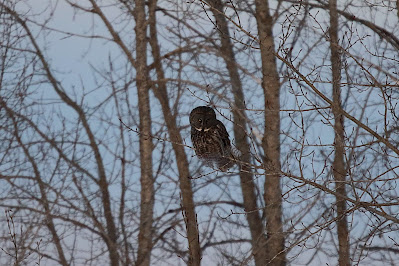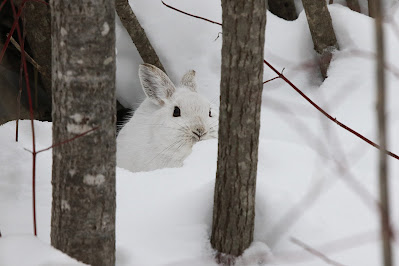Northern Treasures!
A Great Gray Owl and Snowshoe Hare:
Deryl and a friend traveled to northern Ontario recently. One of the target birds was a Great Gray Owl. Although it is visually the largest owl in North America, it is mostly just a ball of feathers. Both the Great Horned Owl and Snowy Owl weigh more than a Great Grey Owl, and they have larger feet and talons!
https://www.allaboutbirds.org/guide/Great_Gray_Owl/lifehistory
Great Gray Owls are powerful birds. Despite weighing only 2.5 pounds, they can break through hard packed snow to grab a small mammal. During winter, they more actively hunt in the daylight.
https://www.allaboutbirds.org/guide/Great_Gray_Owl/lifehistory
A well hidden Snowshoe Hare: Snowshoe Hares prefer dense stands of young conifers or brushy deciduous growth where there is lots of food and good shelter.
They are found in the boreal forest of North America.
https://www.gov.nl.ca/ffa/wildlife/snp/programs/education/animal-facts/mammals/snowshoe-hare/
During the winter, Snowshoe Hares are white, which helps them blend in with the snow. When the seasons change to spring and summer, snowshoe hares become a reddish-brown colour. This change helps them to camouflage among dirt and rocks.
https://www.nwf.org/Educational-Resources/Wildlife-Guide/Mammals/Snowshoe-Hare
Snowshoe Hares feed on a variety of deciduous trees and shrubs, some conifers, grasses and wild plants such as raspberry and fireweed. Because their diet of wood fibre is difficult to digest, hares eat their droppings to extract additional nutrients not absorbed on the first attempt!
https://www.gov.nl.ca/ffa/wildlife/snp/programs/education/animal-facts/mammals/snowshoe-hare/
Rabbits are born blind and helpless, while hares are born fully furred and ready to run! Snowshoe Hares usually have two or three litters a year, born from April to August. The litter size can range from one to eight young.
https://www.nwf.org/Educational-Resources/Wildlife-Guide/Mammals/Snowshoe-Hare







No comments:
Post a Comment